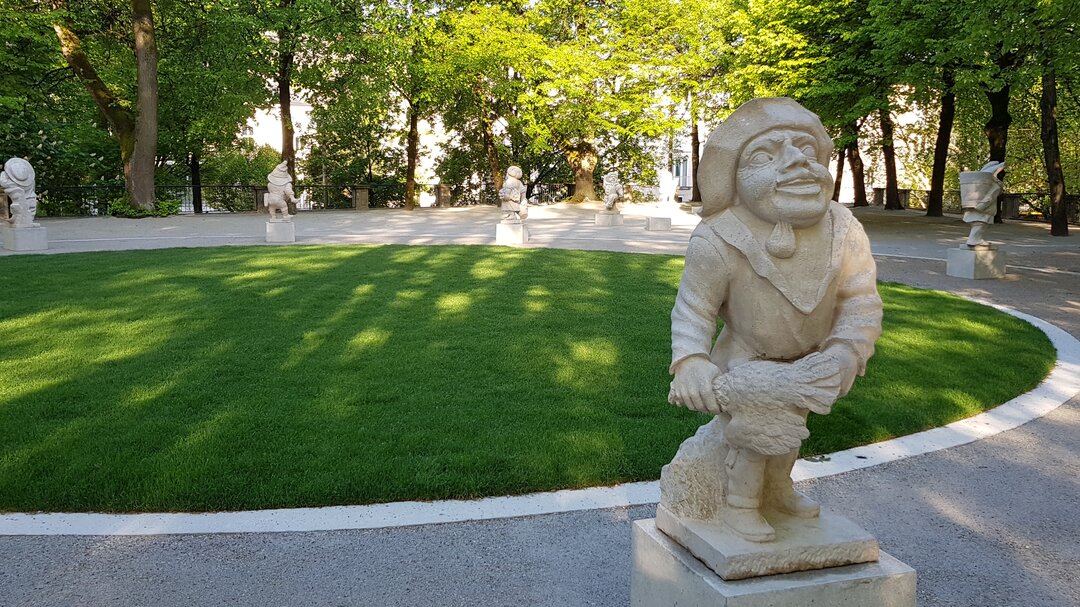Visit us at
Dwarf | © Tourismus Salzburg GmbH
Scenes
In the Realm of the Dwarfs: the Salzburg Dwarf Garden
They have over 320 years under the belts, were sculpted from Untersberg marble, then auctioned off, before finally being brought back to their original home: If the Dwarfs in the Salzburg Dwarf Garden could speak, their tales would probably provide enough material for a Hollywood movie. But even a quiet stroll from one figure to the next reveals many an intriguing background story.
It’s quite a collection of characters that beckon you. They grin mischievously, have a chicken tucked under their arm, or gaze thoughtfully into the sky. And they have certainly had plenty of time to perfect their poses: The famous dwarfs in the Salzburg Dwarf Garden go all the way back to the 17th century. In order to restore their natural beauty, 17 of these little rascals were taken away and given the full “spa treatment” between mid-November 2017 and May 2018. Manufactured from beautiful white marble, since spring of 2018 these cheerful lads and lasses are more radiant than they have been in a really long time. They have also been rearranged on their pedestals into new groups, taking the experience up to a whole new, and even more enchanting level. As we roam through this garden of dwarfs, it becomes clear that each figure plays its own uniquely important role.
Of gardeners and ball players
The dwarf with the spade, for example, is very symbolic. His gaze, directed vacantly skywards, is rather deceptive: This dwarf is an honest-to-goodness gardener. He symbolizes the month of March, in which garden work traditionally begins. The old gardener is one of the best preserved figures of the garden. If you inspect him carefully, you will see that he even sports a bump on his bald pate. Opinions are divided as to why that is: Did the gardener injure himself performing his sometimes-dangerous gardening duties? Or does it represent the “devil’s horn” we also know from harlequin masks? We suggest making up your own mind.
17th-century caricatures
And then there are the two marble chaps ensconced on the bridge leading to the Bastion Garden. You will find this famous pair of baroque dwarfs engrossed in a game that was very popular during the Renaissance, known as Pallone. One player tosses the ball, while the other hits it back with the help of an iron-studded wooden sleeve. If you take a close look at the dwarfs, you will see that the mouth of the dwarf holding the ball is open to shout out a warning, while the “batter” stands ready for the throw. The “pitcher’s” head is actually adorned by a pot – curious headwear, certainly, which clearly suggests the dwarfs are intended as caricatures. In fact, all of the Salzburg dwarfs are indeed derived from caricatures originally immortalized in copper engravings by French draftsman and artist Jacques Callot at the beginning of the 17th century.
A realm of dwarfs in the middle of Salzburg
The Dwarf Garden was originally populated by 28 dwarfs during the time of archbishop Johann Ernst Graf Thun. As a consequence of the Enlightenment, the dwarfs were banned from Mirabell Gardens in the early 19th century and eventually auctioned off. Their value to art history was only recognized more than one hundred years later. And so it came about that, in 1919, they were brought back from gardens across Salzburger Land, the Hausruck and Bavaria, and returned to the places they had originally stood: in the very heart of Salzburg. Admittedly, they now only number 17 and no longer stand in the original Dwarf Garden, but rather in the neighboring Small Bastion Garden, also known as the “Water Bastion”. But Salzburgers are proud of their dwarfs and the oldest dwarf garden in Europe. And who knows – perhaps, sometime in the future, all of the marble figures will be reunited on the historic soil of Hellbrunn’s baroque gardens – in their own small, yet magnificent realm.














